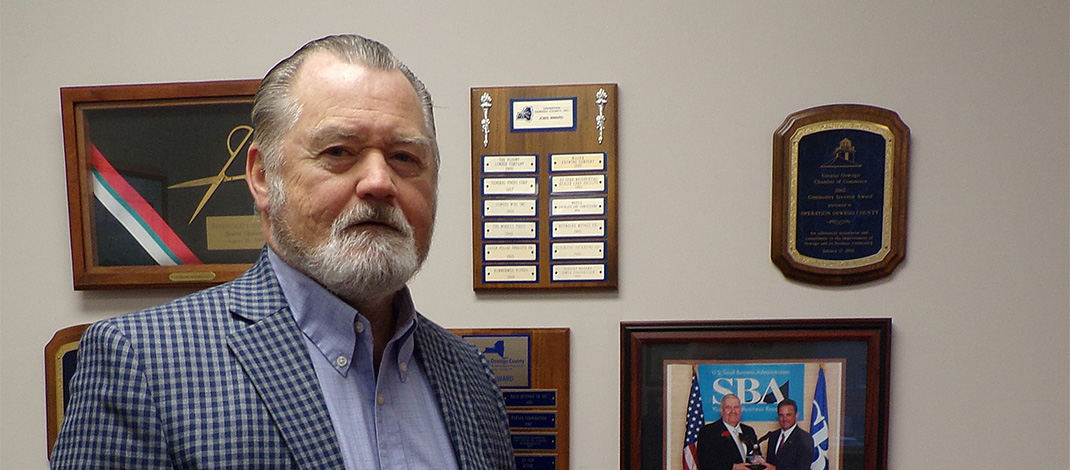Talks about losing companies — Nestle, Miller Brewing — retainting others
L. Michael Treadwell is stepping down at the end of the year from his position as executive director of Operation Oswego County after nearly four decades of service. He joined Operation Oswego County in 1983 and has served as executive director throughout his tenure.
Q: It’s early December and you are still very busy tying up lose ends here at Operation Oswego County. Are you looking forward to being able to slow down after you retire?
A: I have plenty to keep me busy. I have a couple little 4-year-old grandkids. Both of my daughters, one lives in Manhattan and one lives in New Jersey — I’ll be around them a lot and doing things. I’ll have an opportunity to, you know, run around a little bit.
Q: So, you are planning to do some traveling, too?
A: We’ll visit some friends I’ve worked with back in South Carolina and Georgia. Scoot around a little bit. Probably grab a suitcase every once in a while and take a little trip. I’ve got a lot of things that I’d like to be doing but haven’t due to work commitments. My wife retired from teaching about five or six years ago. She’s been waiting for me to get free time so we can take some extended trips. We’ll be going back down south, South Carolina and Georgia, where I’m from. We have some friends in Florida, too. So probably some trips down there.
Q: So, you are going to stay warm.
A: Yes. I don’t want to travel to colder weather so we will be headed to warmer climates. I’m probably going to have to develop some new hobbies and stuff —my current hobby has been work.
Q: How would you describe your time in Oswego County?
A: I’ve had a lot of fun. I’ve had a lot of challenges, also. I kind of got separated from the family the last few years. Now I can get back into the family mode.
My wife was down in New Jersey most of the time; we have a house down there and she wanted to be closer to the grandkids. And I was up here most of the time.
Q: What are you most proud of?
A: I was in economic development in South Carolina, working for the state in South Carolina for about 11 years before I moved up here. I was working at the state level. Came up here and faced a different challenge because I was at the local level. They (OOC) had a lot of good programs that had been successful. Probably what I am most proud of is, over time, coming here and turning the organization in to a — it was more of a one project by one project type of structure — we turned it into a more comprehensive and diversified economic development agency. They were just starting to build the industrial park and that has turned out to be very, very successful.
Q: Anything else?
A: The Broadwell hotel that was a major project. The Captain’s Quarters Best Western. That entire strip, right up to now with the water park — a massive project that’s close to my heart. The other thing is how we all worked together to save the FitzPatrick power plant and make it a sellable facility. That was basically a two-year project.
Q: Your improvements in southern Oswego County have been rather fortuitous given the Micron announcement, haven’t they?
A: We have grown and expanded it [the industrial park] just in the nick of time, right before Micron got started. I don’t know how that area could be more strategic than it is right now. There will be an extensive amount of demand placed on properties in that area. Not only for business related things, but development for housing and other types of commercial activity, too. That one project [Micron] will translate into hundreds of other projects.
Q: So, big projects are what you hope for?
A: Things don’t have to be huge to be very satisfying in terms of getting accomplished. One thing that I really am most proud of is back in 1995 was the potential of losing Sealright Packaging. It was between staying in Fulton or moving to Kansas. Working with the city, Mayor [Don] Bullard at that time, the state, the Pataki administration, and the state economic development office and a bunch of other players we were able to save that plant, which is today thriving as Huhtamaki.
Q: How did you do that?
A: Working with the state, we got some money to basically “create land” so they could expand their campus. Tore down a huge old building that was non-functional and we worked with the city to turn over a street that went right between the Sealright properties. There was a junk yard sitting in the back of Sealright. The IDA and the city worked together to acquire that junk yard and had it cleaned up — they created a site that became their major distribution hub. None of that could have worked without everybody working together.
Q: So, there has been a lot of success?
A: For the most part, yes, the fun has outweighed the tough parts. You do lose in economic development, no question about that. It’s like baseball. Sometimes you hit a homerun with a great project like EJ USA — big expansions at Novelis and other companies like HealthWay. But you also lose projects.
Q: What losses stick out in your mind?
A: Miller for example; that was just a matter of over-production. They realized they had too many plants in the northeast and guess what the Volney plant happened to be the oldest one and that was the one that got shut down.
And the Nestle project is another. It was probably one of the most frustrating failures. They had the expertise; they knew what they were doing. We should have had that plant operational again after Nestle.
That project died for one reason and one reason only — you had some corrupt individuals that were stealing money that was supposed to be going into developing the facility. It failed because of corruption. If not for that, that facility would have gotten back into the production of chocolate.
Q: You’ve been here since 1983. Have you ever thought about moving on? What’s the secret to your longevity?
A: When I came here back in ’83 my intention was to work here maybe two or three years and then move on, kind of like a stepping stone. I interviewed for this job and met some super great people. I had a number of opportunities to leave and take other positions. But I liked the folks we were working with and enjoyed what we were doing and the progress we were making. I guess it was like starting a painting, you want to finish it; you don’t want to walk away from it. So I hung around. I enjoyed it. I still enjoy it and the people that I deal with.
Q: Looking ahead, what is your prediction for Oswego County’s future?
A: My prediction is that with the appropriate planning and development that Oswego County and all of Central New York is going to have a tremendous economic boost because of the Micron project.
Thank God we already bought that property in Schroeppel. If we hadn’t been aggressive in trying to piece something together to have a significant contiguous industrial site with four-lane highway access and rail, things would be different.
We still have to make some improvements in infrastructure down there to make everything fly, but that’s being worked on. We felt when we bought that property that we significantly overpaid for it. But, we bit the bullet and got control of the property. If we had to do that again today, I guarantee you we’d pay five to 10 times as much. I don’t know if we could afford it. We’ve got a lot of things going for us down there.
The outlook is super, super positive. There is a lot of potential all over.
Micron will have decade of impact on the region.




